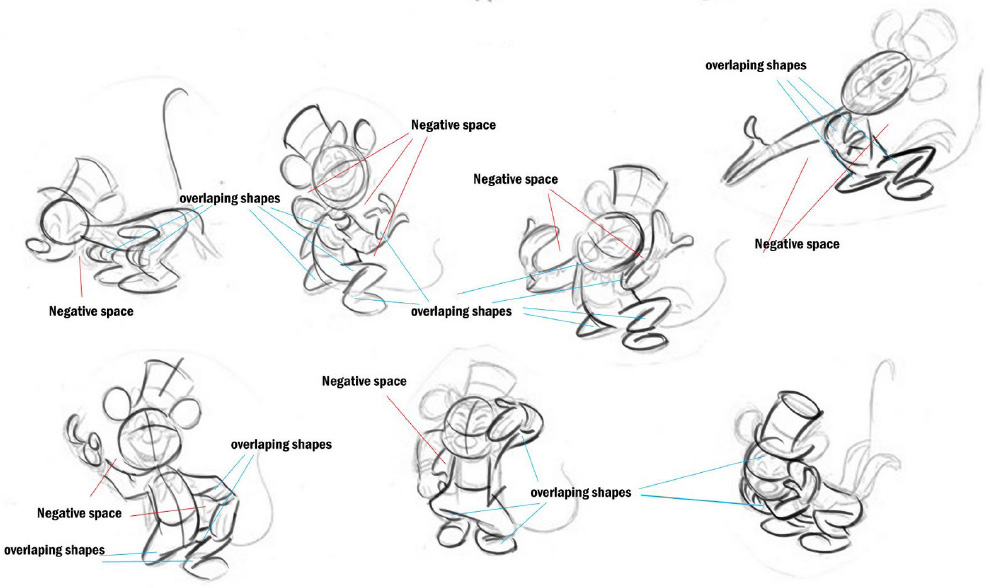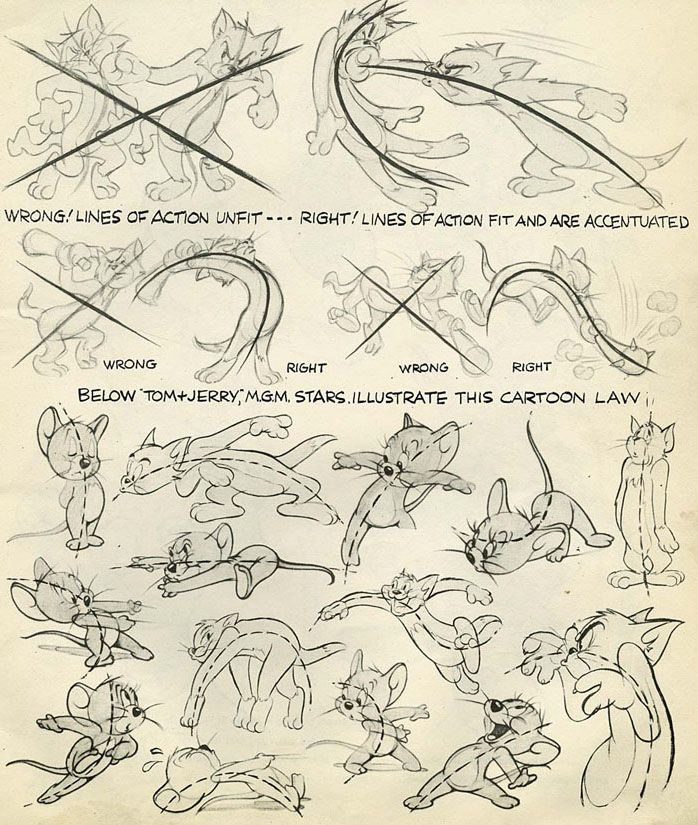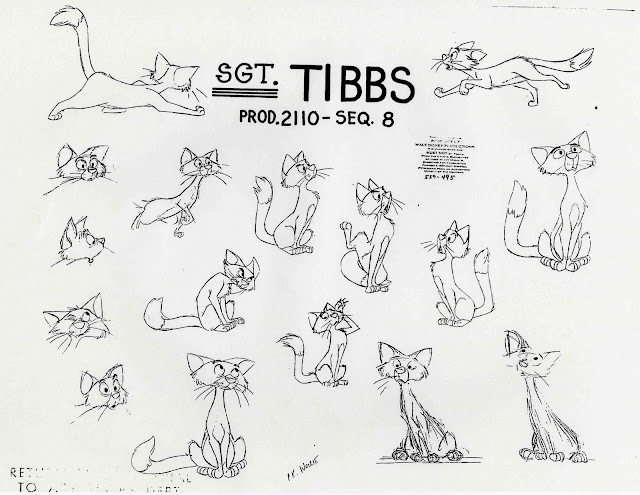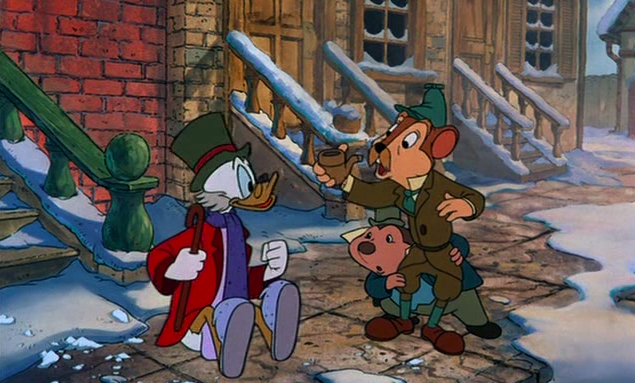Line of Action - Mickey's Christmas Carol
The line of action is a key ingredient to making your character’s
poses look more dynamic.
As shown in this post, the position and posture of the characters in the scene can greatly effect the staging and composition for any animated scene. In addition, it can help to place the characters within the situation, making them part of their environment and the story.
Some ways to strengthen the pose (and overall composition) of the character is to create a nice silhouette, this is the overall shape of a pose. This shape should read clearly even if the pose were filled in black you would still be able to tell what the character is doing.
The use of negative space and overlapping shapes for posing characters creates clear silhouettes, see the empty spaces between the arms and legs and major forms in these drawings:

Another method is to create a strong line of action through your character. This helps your poses "read", it makes them clear and understandable and gives them a distinct non-ambiguous direction.
Here's some Preston Blair examples with Tom & Jerry:

If you study classical paintings, photography, comic books, and graphic design - you'll find that they all use this same principle. You need only to look at nature to find these lines of action:
The one thing that will really bring your drawings to life is that 'line of action'. You can think of it as the back bone of a character or just as the imaginary line that dictates how the body will move. This line should always be used in setting up a pose.
Lines of action are not limited to characters alone, here's samples by Bill Peet on how invisible lines can be found in the overall layout of a well composed scene or illustration to create rhythm, flow, and a focal point within the shot:
Most storyboard
artists and animators follow this method as a basic principle for planning out
the acting and motion of the animated characters - their attitude and behaviors
become expressed through their physical body.
Body language comes in clusters of signals
and postures, depending on the internal emotions and mental states, there is lots of non-verbal communication going on in every pose, see
samples here.
More Reference - Here's an article by John K. where he specifies how animator Ed Love connects consecutive poses together. He doesn't always do an antic and an overshoot, and he doesn't time the connections the same way for each pose. What he does do, is control the whole sequence with a hierarchical structure of poses. Some poses and actions are more important than others, and he uses all the drawing and animation tools to keep your eye following the important parts of the action.
 Here are the 2 poses we see and feel in the animation.
They are holds. They are drawn with perfectly clear negative spaces, contrasts
and lines of action. The action happening between them is visually obvious. Buzz
stretches Woody up. The action is clear in just the still poses.
Here are the 2 poses we see and feel in the animation.
They are holds. They are drawn with perfectly clear negative spaces, contrasts
and lines of action. The action happening between them is visually obvious. Buzz
stretches Woody up. The action is clear in just the still poses.


 Not every part of the second pose overshoots. The
overshoot is focused on the main part of the action: Buzz' arm stretching
Woody.
Not every part of the second pose overshoots. The
overshoot is focused on the main part of the action: Buzz' arm stretching
Woody. Focus of action gets to the final pose first. The rest
catches up.
Focus of action gets to the final pose first. The rest
catches up.These lines of action can be found everywhere.

So when I watched Mickey's Christmas Carol on television last Christmas, I knew I had to take a few screen captures from this classic. As shown in the 150 poses below, they help illustrate the power of this imaginary line extending through the main action of the figure. For purposes of effective body language and visual storytelling, see how the body bends and forms their emotions.
I've also shown a few samples of the Rule of Thirds in action as well. There should always be one or two hotspots within any given scene, and if one were to align the subject within the range of influence of these hotspots, it always makes for a more energetic and interesting composition. Imagine a pair of lines dividing the picture into thirds horizontally and a second pair dividing it into thirds vertically. Place the most important visual element (usually a significant object, the character's face or sometimes the eyes in a close-up) on one of the points where the lines intersect. Live-action cinematographers use this rule very often. Following this "tic-tac-toe grid" ensures that the main focal point is off center, well balanced, and allows some open space in front of the characters.
Here's lots more samples of strong postures. Observe the line of action and how it conveys the extent and direction of the pose.
You can also create dynamic compositions that help to tell the story by using action/reaction poses. One character causing the action, the other character(s) react or follow the action. By using Opposing Poses like in the examples shown here, you can have characters curved or directed on an arc, other characters have straighter poses, but still aimed on an angle. This kind of dynamic posing sure beats the hell out of characters standing straight up and down all the time.
Incredibly strong and clear poses, observe how every character and situation have their own distinct lines of action.
There are lines of action in the environment also, these leading lines are naturally occurring lines that direct the viewers eye and draw attention to certain parts of the shot. Usually the character because that is the main focus, background elements and props are designed and positioned to lead the audience's eyes.
See how that line in the background intersects through (behind) his eyes, it's done on purpose to create a focal point with the strong line of action in his pose.
Lines of action can help with showing a character's dominance over another.
Lines of action that run through the spine can display confidence or shyness without any dialogue.
The curve in the body's poses is a very common method, the reversal of that curve is important to transition from one posture to the next. Its nice to contrast between backwards and forwards curves in your poses, and also straights against curves.
Triangular composition occurs when the placement of the subjects (or group of elements themselves) form the shape of a triangle. Sometimes to create depth, other times to break up the image for variety in spacing and positioning, and often to create a connection or relationship between the different subjects.
In combination with contrasting poses in the characters and you have some nice simple staging happening here.
More triangular compositions, and observe how the characters' postures play off each other.
Mike Peraza was an artist who worked on the special, here you'll find him talking about is memories regarding how the production came to be.
Staging your characters involves many different aspects - Composition, lighting, perspective, camera angle, negative space, visual balance, the scale of the character compared to other elements on screen, avoiding tangents, parallels, and twinning, all while using the characters' mass, size and overall shape as part of its personality. In addition, a nice balance of curved and straight lines in a character's postures and actions must be achieved to compliment the acting intended. The attitude and behaviors of the character, facial expression, and body language are all things to consider when creating a set of poses. The stronger the poses the more appealing the animation will be. The Line of Action can help you in creating those strong poses, and better storytelling.




































































































































































No comments:
Post a Comment